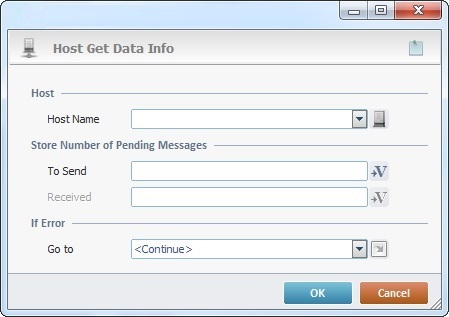Working with Host Get Data Info Process
Process Purpose
The data being sent to a defined host are organized into a message or messages.
The "Host Get Data Info" process handles the messages in queue that have not yet been delivered to the host and the ones that have been sent from the host - it retrieves the number of pending messages.
This process can only be used if your application development leads to an asynchronous communication between device and host (a synchronous communication does NOT queue outgoing/incoming messages, so, this process cannot execute).
When you add a process, you are required to define its settings. This occurs in the process's properties window which is displayed automatically after having added the "Host Get Data Info" process.
If any subsequent edition is required, double-click the process to open its properties window and enter the necessary modifications.

Fill in the following:
Host |
|
Host Name |
Select the host profile that receives messages (data) from the application from the drop-down OR click See To Create a Host Profile OR To Edit a Host Profile OR The <Default> Host Profile. |
Store Number of Pending Messages |
|
To Send |
This field retrieves the number of messages in queue to be sent to the host. Click |
Received |
Under Development. This field will retrieve the number of messages in queue that were sent by the host. Click |
If Communication Error |
|
Go to |
Select a target location from the drop-down or
|
Detail of a ![]() window:
window:

"S:Menu" is a screen included in the same program as the process.
"R:Routine_1" is a routine included in the same program as the process.
Use ![]() to attach any relevant notes to this process. Click it and enter your notes in the resulting text box. These notes will be displayed in the corresponding "Actions" tab or "Process" window (in the "Notes" field) and in the "Developer Report".
to attach any relevant notes to this process. Click it and enter your notes in the resulting text box. These notes will be displayed in the corresponding "Actions" tab or "Process" window (in the "Notes" field) and in the "Developer Report".
After filling in the required options, click ![]() to conclude or click
to conclude or click ![]() to abort the operation.
to abort the operation.
The added process is displayed in the corresponding "Actions" tab or "Process" window.
![]() If you want to use a label as a target destination, you can use the "Auto-Label" mechanism. This alternative to the "Set Label" process allows you to create a label in the properties window of a process - specifically, in the fields used to define target destinations (ex: the "If Error..." type fields). See To Automatically Create a Label.
If you want to use a label as a target destination, you can use the "Auto-Label" mechanism. This alternative to the "Set Label" process allows you to create a label in the properties window of a process - specifically, in the fields used to define target destinations (ex: the "If Error..." type fields). See To Automatically Create a Label.
![]()
Use the right-click in MCL-Designer's input boxes to access some related options as well as the general "Cut", "Copy"; "Paste"; "Search" actions (active/inactive according to the current context).
Ex: If you right-click the "Variable" input box (included in a "Conversion's" properties window), you are provided with general editing/search actions and other more specific options such as "Variable Select" (see "Variable Select"); "Variable Insert" (see "Variable Insert"); "Insert Special Character" (see To Insert Special Characters into a Control's Text Input Field) and "Localization Select" (see Localization List).
If you right-click another input box, it may provide other possibilities.
